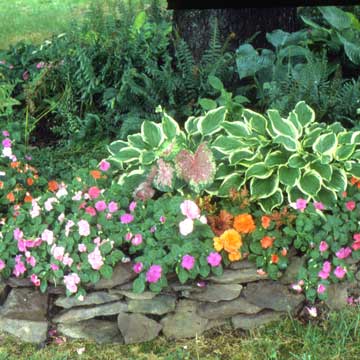






When perennials bloom poorly or produce little or no seed, they can try again the next year -- but annuals do not get a second chance. And because annuals work hard to form flowers, gardeners want to help them put on the best show possible.
Learn how to mulch your annuals.
continue reading belowLike other plants, annuals need the big three nutrients -- nitrogen, phosphorous, and potassium -- along with smaller amounts of secondary nutrients such as magnesium and calcium, and minute quantities of trace elements, including boron and iron. Healthy soil, rich in organic matter, provides the basic nutrition most plants need, and usually contains adequate amounts of trace elements and secondary nutrients. In organically-rich soils you can probably grow many annuals without supplemental fertilizers. But at times adding compost is not enough. Some annuals want more nutrients, especially if they are grown in pots. Every time water drains through the hole at the bottom of the container, nutrients in the soil are carried along with it, and they should be replaced.
In addition to incorporating organic amendments into the garden soil each year, give periodic applications of fertilizers containing all three major nutrients to ensure that your annuals are well-nourished. If a soil test shows your soil is deficient in secondary or trace minerals, supply those as well (USDA and private soil-testing laboratories will instruct you on what to add to bring the nutrients up to acceptable levels).
For flowering annuals, use an all-purpose plant food, such as a 5-10-5 or 10-10-10 formula. Flowering plants have a special need of phosphorous and potassium to realize their blooming potential. Foliage plants will flourish with a formula higher in nitrogen (the first of the three numbers in a fertilizer formula).
Whatever type of fertilizer you choose -- granular or liquid, synthetic or organic -- follow the directions on the package for how much to use and how often to apply it. Overfertilizing is worse for plants than feeding them too little. Too much fertilizer causes rapid, weak growth that is susceptible to damage by pests and diseases, and excess fertilizer runs off and may find its way into the water table, causing pollution.
Granular Fertilizer For annuals in beds and borders, granular fertilizers are one option. Spread granular fertilizers over the soil around the plants and scratch them in lightly. Then water. You can apply synthetic granular fertilizers at planting time and periodically throughout the growing season. It takes more time for the nutrients in organic fertilizers to become available to plants, so these fertilizers are usually applied in spring before planting. Rock powders such as phosphate rock and granite dust, which organic gardeners use to supply phosphorous and potassium to the soil, break down very slowly and should be added in fall to nourish plants in next year's garden.
Liquid Fertilizers Liquid fertilizers are ideal for potted plants. Years ago, committed organic gardeners made manure tea by steeping fresh manure in water, eventually producing a dark brown liquid. Manure tea works like a wonder, but it's not a pleasant way to accomplish the job. Today there are a number of liquid fertilizers on the market that are environmentally safe yet contain the nutrients needed to ensure good plant growth. One of the best is a concentrate called fish emulsion, but be sure you look for the deodorized form, especially if you ever plan to use it indoors. You can follow the instructions on the package or dilute the concentrate to half the recommended strength. A half-strength solution saves money while providing adequate nourishment. It also keeps you from overfertilizing plants. Apply liquid fertilizer every three or four weeks, especially to potted plants.
Copyright © www.100flowers.win Botanic Garden All Rights Reserved